What About Additional Characteristics of an Admired Leader?
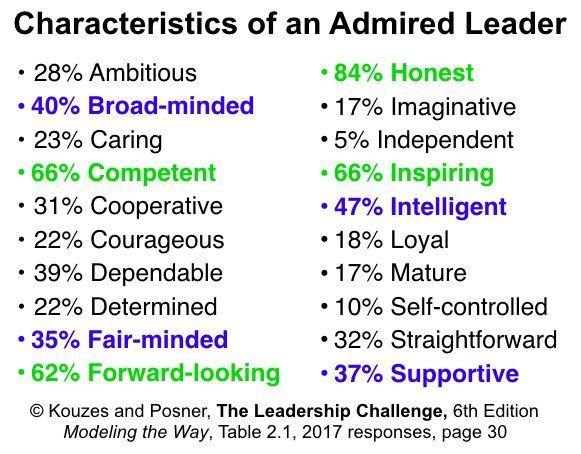 James Kouzes and Barry Posner, The Leadership Challenge, have been surveying followers for over the past thirty years on what are the top seven characteristics out of twenty of an admired leader. Look at the latest results from the 2017 survey on the left. The top four characteristics of an admired leader are honesty, competence, inspiring, and forward-looking. These four characteristics have been consistent over the past thirty years. The first three characteristics – honesty, competency, and inspiring are in line with the currency of leadership, credibility. The pillars of credibility rest upon trust, expertise, and dynamism. Do you agree with Kouzes and Posner’s findings? Do you see the parallel with these characteristics and credibility? How is your credibility? How are you on being forward-looking? Do you have a vision for the future? Is it strategic? Is it viable? Is it inspiring?
James Kouzes and Barry Posner, The Leadership Challenge, have been surveying followers for over the past thirty years on what are the top seven characteristics out of twenty of an admired leader. Look at the latest results from the 2017 survey on the left. The top four characteristics of an admired leader are honesty, competence, inspiring, and forward-looking. These four characteristics have been consistent over the past thirty years. The first three characteristics – honesty, competency, and inspiring are in line with the currency of leadership, credibility. The pillars of credibility rest upon trust, expertise, and dynamism. Do you agree with Kouzes and Posner’s findings? Do you see the parallel with these characteristics and credibility? How is your credibility? How are you on being forward-looking? Do you have a vision for the future? Is it strategic? Is it viable? Is it inspiring?
While I think these four characteristics are essential for a leader to live into, I believe three components are missing from these twenty: humility, hope, and gratitude. I look for these three characteristics in leaders I choose to follow (and vote for!)
Humility. Humility is an essential topic in the Bible and written about in seventy-three verses. Prayer is a pillar of the Muslim faith. Everyone in prayer is equal. Thus prayer is founded on piety. Humility is piety. In the Jewish tradition, humility is among the greatest of the virtues – greatness is humility. While humility is a cornerstone in the world religions, it turns out to be essential in leadership in the secular world. Jim Collins, Good to Great, discovered leaders in the eleven great organizations had two critical behaviors: personal humility and indomitable will. How is your humility? If you are not sure, take an emotional intelligence 360 assessment. It will give you insight into where you stand as well as develop action steps to become more humble.
“Humility is not thinking less of yourself, it’s thinking of yourself less.” – C.S. Lewis
Hope. Sometimes people need hope more than food to stay alive! Hope is not wishful thinking, optimism, or a positive attitude. Hope is a call to action. Hope is the anticipation of something better coming, a blessing in the offing, a new, brighter tomorrow that you can have a hand in creating. Leaders with hope, who speak strongly about hope, who make hope come alive will have followers who will exceed expectations.
“You may say I’m a dreamer, but I’m not the only one. I hope someday you’ll join us. And the world will live as one.” – John Lennon
Gratitude. We are bound up in consumerism, competition, and individualism. These behaviors cause us to compare ourselves to others and feeling sorry for ourselves when we see what we don’t have. Happiness is contingent upon that next shiny object, a new job title, a bigger office, a higher salary, a new car, a bigger home, and the latest tech. We continuously fail at being mindful of how we are, what we have, and who has helped us. Gratitude causes us to appreciate what we take for granted, especially the people in our lives. Leaders who live into gratitude are some of the most joyful people I know. Their joy is infectious, inspiring, and cherished. How do you measure your gratitude? When do you take inventory for what you are grateful? How often do you show your gratitude? How do you share your gratitude? Sheldon Yellen, CEO of the property-restoration company BELFOR Holdings, Inc., hand-writes birthday cards to each of his 9,200 employees as well as thank-you notes, anniversary cards, holiday cards, and even to his employees’ kids when they are sick. He has created a culture of compassion through the whole company.
“Joy is the simplest form of gratitude.” – Karl Barth
My leadership challenge to you is to nurture your humility, hope, and gratitude!

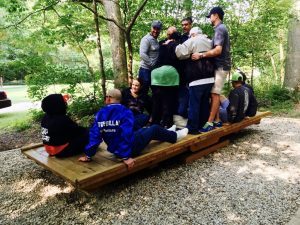
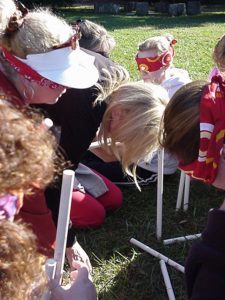
 My second mentor was Craig Rider,
My second mentor was Craig Rider, 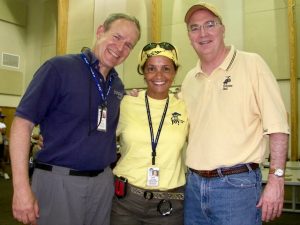
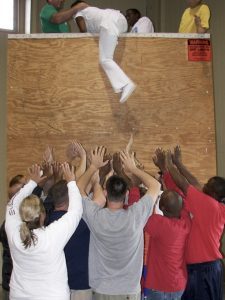 based initiatives in my toolbox is the Group Wall. Its a good initiative to do with groups when they have reached a plateau of either thinking “we’re good,” when egos are still at play or the group is still not collaborating well. Done well, it demonstrates the need for humility, understanding, communication, critical thinking, patience and ultimately, the need for one another.
based initiatives in my toolbox is the Group Wall. Its a good initiative to do with groups when they have reached a plateau of either thinking “we’re good,” when egos are still at play or the group is still not collaborating well. Done well, it demonstrates the need for humility, understanding, communication, critical thinking, patience and ultimately, the need for one another.


